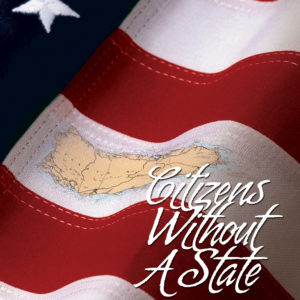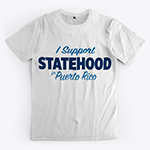The Puerto Rico Status Act presents three options for Puerto Rico’s political status:
- independence
- free association
- statehood.
There are 50 existing states, and the U.S. Constitution guarantees that Puerto Rico will be on an equal footing with all the existing states. 32 of these states used to be territories of the United States, but most Americans could not identify all of them; there are no differences between those that were once territories and those that were not. Therefore, we have 50 good examples of what it is like to be a state.
There are three Freely Associated States, independent nations in free association with the United States, and they can serve as examples of what it might be like to be in free association with the United States.
There are nearly 200 independent nations, and perhaps they can serve as examples of independence. However, none of them has a special relationship with the United States allowing free travel, work, and study. None has universal dual citizenship with the United States. None gets guaranteed financial support. These are things that the Independence Party imagines the United States will give to Puerto Rico.
The example of the Philippines
There is one nation that used to belong to the United States and is now independent: the Philippines. There were and are many differences between the Philippines and Puerto Rico, but it could be instructive to look at a message sent by President Calvin Coolidge, then President of the United States, and the Governor of Puerto Rico in 1927.
It had been suggested that the Philippines should have a status referendum. The object was to find out whether the people of the Philippines wanted immediate independence at that time. The Philippine Organic Act of 1902 had established that people born in the Philippines, or living there when it was a colony of Spain, would be citizens of the Philippines unless they chose to remain citizens of Spain. The same arrangement was created for Puerto Rico giving U.S. citizenship unless individuals chose to remain subjects of Spain. However, both the Philippines and Puerto Rico belonged to the United States and were under the authority of Congress. It was intended that the Philippines would become independent, but the timeline for independence was not settled.
The referendum was to have one question: “Do you desire the immediate, absolute and complete independence of the Philippine Islands?”
Just as other territories of the United States have been asked if they want statehood, yes or no, the Philippines was to be asked whether they wanted independence, yes or no.
“The voter must vote categorically ‘Yes’ or ‘No’,” Coolidge reminded the Governor. “Any other reply invalidates the ballot. The result of the vote having been ascertained, the Governor General is to transmit it to the President and Congress of the United States for their information. It should be noted that the object is to register a desire. There is no petition, and no change in status is contemplated.”
This would have been, then, the same kind of nonbinding plebiscite that Puerto Rico has had over the years.
Coolidge did not support the plebiscite
President Coolidge did not support the plebiscite. For one thing, he felt that the question was too cut and dried. People might reasonably want independence, but not immediately, he felt. They might want independence, but with some kind of continuing support from the United States. A Yes/No vote would not allow anyone to express these more complex preferences.
“Independence is a very appealing word,” he wrote. “Few people will vote against independence for themselves or against independence for anybody else. To submit to a man the question whether he desired to be independent, or not, is really trifling with the sacred feelings innate in humankind, and to submit it in a way which would forbid the possibility of other than a ‘yes’ or ‘no’ answer is obviously not the way to secure a convincing reply.”
He also thought that holding the plebiscite might give the people of the Philippines the false impression that the United States was ready to grant independence immediately, or that the vote would require action by Congress. “Submitting to the vote of the people the question of independence, unless such action is requested by the Congress of the United States, can be but disturbing to good relations,” he said.
Coolidge did not support immediate independence
Coolidge expressed admiration for the culture of the Philippines and for the development and advancement of its institutions, but pointed out that its strong position was at least in part thanks to the economic support of the United States.
“This phase of the question has not received careful consideration in the Islands because of the misapprehension which seems to be quite general there that America, even though she granted full autonomy to the Islands, would still assume the heavy responsibility of guaranteeing the security, sovereignty and independence of the Islands,” he suggested. “In my opinion this is wholly erroneous. Responsibility without authority would be unthinkable. American defense is a correlate of American sovereignty, not of foreign sovereignty. Where there is no sovereignty there is no obligation of protection.”
He went on to say, “The people of the Philippines should not consider this momentous question with the mental reservation that the present advantage of American sovereignty could be secured by convention or through sympathy, though the sovereignty were relinquished. Freed from this illusion, the people and their leaders should thoroughly ponder the advantages which they have received from their connection with America and attempt to depict the situation which would result from the withdrawal of the benefits which they are now receiving from the United States.”
Coolidge listed some of the advantage he saw to the relationship between the United States and the Philippines, including free trade and access to the U.S. market. He went into detail on the specific exports and the tariffs waived by the United States. “Reference is sometimes made to the possibility of overcoming these losses by trade conventions or other methods,” he wrote, “but no independent country has ever secured similar advantages.”
Coolidge acknowledged that economic issues were not all that caused people to desire independence.
“While these material advantages are by no means the most important consideration which should influence our judgment,” he wrote, “yet they must be always kept in mind, as government is a practical business which depends largely for its success on sound common sense rather than high-sounding phrases.”
Is any of this like Puerto Rico’s position?
The Philippines became independent in 1946. They had never considered statehood, and were not U.S. citizens. Coolidge’s attitudes were typical of people in the 1920s, not the 2020s.
But supporters of independence for Puerto Rico often suggest that an independent nation of Puerto Rico would be able to keep many advantages of the current connection with the United States, including (in the Puerto Rico Status Act currently being considered in Congress) keeping the money paid into Social Security, continuing to receive veterans’ benefits, and being able to trade freely with the United States. The Philippines did not get any of these things.
As Coolidge pointed out, many people expected the United States to continue to provide these things. There was even an agreement at one point that Filipino veterans of the U.S. military would receive veterans’ benefits. A later president — President Dwight Eisenhower — signed a bill from a later Congress that took those benefits away.
Independence supporters talk about reparations made from the United States to Puerto Rico. They say that Puerto Rico’s trade relationship with the United States would be “on San Juan’s terms.” They claim that the end of the application of the Jones Act would reduce the cost of living, without considering how the loss of federal funding would affect those costs. They seem to echo Coolidge’s suggestion that the people of the Philippines would expect the United States to maintain support for a former territory “by convention or through sympathy.”
The Constitutional Rights Foundation lists the things they think would be true of an independent Puerto Rico:
- Puerto Rico would become a sovereign nation with its own political system, language, culture, and membership in the United Nations.
- The United States would no longer be obligated to provide financial support, but would lose all military bases unless Puerto Rico agreed to lease them.
- Some or all Puerto Ricans would likely lose U.S. citizenship and the right to reside in the United States.
- Puerto Rico would be a poor nation, depending on foreign aid from other nations.
Which of these pictures is more likely? It is impossible to tell ahead of time what the outcome might be. The Philippines wanted independence, and its people were willing to go through the struggles involved in gaining that independence. The majority of people living in Puerto Rico do not want independence and are not willing to go through that process. Independence supporters should not pretend that it would be easy.








No responses yet